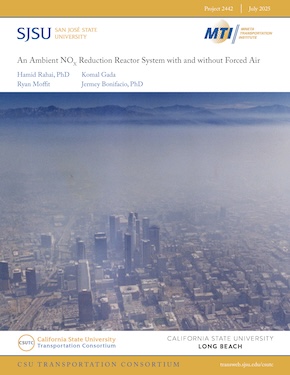- 408-924-7560
- mineta-institute@sjsu.edu
- Donate
An Ambient NOx Reduction Reactor System with and without Forced Air
Ambient nitrogen oxide (NOX) is one of the main ingredients involved in the formation of ground-level ozone (smog), which contributes to global warming and the formation of particulates in the atmosphere and causes respiratory illnesses, especially in children, older adults, and people with lung diseases. Investigations on adding titanium dioxide (TiO2) nanoparticles to the paint used on concrete surfaces such as buildings and its potential in reducing ambient NOX concentration have provided opportunities for the research and development of methods for passive control and filtration of the ambient NOX. The present research used numerical geometrical optimization to identify an optimized surface geometry of half-stepped cylinders for increasing air recirculation and residence time for maximum ambient NOX reduction. The optimized surface was painted with titanium-infused paint and tested for NOX reduction according to ISO 22197-1 standard. Results showed a maximum of 11.5% increase in NO2 formation for an optimized surface compared with the result for the untextured smooth surface, with an estimated NOX reduction of approximately 15%. The results provided guidelines for developing a catalyst system for reducing ambient NOX when UV light is present. These results demonstrate potential of using paint infused with titanium to help reduce NOX and thus reduce smog, which harms people and the environment.
Hamid Rahai, PhD
Dr. Hamid Rahai is a professor in the Department of Mechanical and Aerospace Engineering & Environmental Engineering and is the director of the Center for Energy and Environmental Research & Services (CEERS) in the College of Engineering at California State University, Long Beach (CSULB). He has taught various classes at the undergraduate and graduate levels in thermal sciences, supervised over 75 MS theses and projects and PhD dissertations, and published more than 100 technical papers. He has been granted patents for the development of a high-efficiency vertical axis wind turbine (VAWT) and wind turbine apparatuses and for reducing NOX emission of Cargo Handling Equipment using a Humid Air System. He also has pending patents on a new guide-vane enclosure for capturing wind energy from passing vehicles, optimized end-plates and airfoils for improving the performance of vertical axis wind turbines, and optimized surfaces for reducing ambient NOX. Dr. Rahai is the recipient of the 2004 Northrop Grumman Excellence in Teaching Award and the 2012 CSULB Impact Accomplishment of the Year in RSCA Award. He received the Outstanding Engineering Educator Award from the Orange County Engineering Council in California in 2014, and in 2019 he was inducted as a senior member of the National Academy of Inventors (NAI).
Rylan Moffit
Mr. Ryan Moffit is a graduate student in the joint PhD program between the CSULB College of Engineering and the Claremont Graduate University (CGU) and a Research Assistant at the Center for Energy and Environmental Research & Services (CEERS) in the College of Engineering at CSULB. Mr. Moffit is an experimentalist. His research is focused on finding an optimized surface geometry for reducing the drag of vehicles. He has authored and co-authored two ASME conference papers.
Komal Gada
Mr. Komal Gada is a graduate student in the joint PhD program between the CSULB’s College of Engineering and the CGU and a Research Assistant at the CEERS in the College of Engineering at CSULB. Mr. Gada specializes in numerical optimization and computationalanalyses. His research is focused on the effects of coil inserts on a pipe-jet in crossflow, vehicle drag reduction, and particle transport within confined spaces. He has authored ten journal and conference papers.
Jeremy Bonifacio, PhD
Dr. Jeremy Bonifacio is a teaching professor and a senior researcher at the CEERS in the College of Engineering at CSULB. His expertise is experimental and computational fluid mechanics. He has been involved in various applied industrial projects at CEERS and is co-owner of several patents related to emission control technologies and the application of CFD in diagnosing lung diseases. Dr. Bonifacio is the winner of the CSULB 2014 innovation challenge.
-
Contact Us
San José State University One Washington Square, San Jose, CA 95192 Phone: 408-924-7560 Email: mineta-institute@sjsu.edu






